2018 Honda Odyssey

Kilauea, the most active of the five volcanoes that make up Hawaii’s Big Island, has had nine major eruptions since 1790. As recently as 1974, it blew its top sufficiently to destroy roads in the southeast corner of the island. Most days, it just percolates along, venting a perpetual plume of sulfur dioxide while searing red magma gurgles for the tourists who funnel by for a glimpse.
Piloting Honda’s new minivan in this geologically intense location had us pondering the Odyssey’s somewhat more predictable (but no less devastating, to the competition in this case) cadence of four melt-and-repour overhauls since it burst onto the scene for the 1995 model year. But even these eruptions haven’t changed much. For example, the 118.1-inch wheelbase hasn’t budged since the Odyssey’s second generation (the first-gen Odyssey was Accord-based and significantly smaller), even for this 2018 overhaul that moves the Odyssey to the latest architecture shared with the Pilot crossover and the Ridgeline pickup. The SOHC V-6’s 3.5-liter displacement also has remained constant since it was installed in 1999; however, output has increased from 210 to 280 horsepower during that time. The latest version adds direct fuel injection, enabling a full-point increase to the compression ratio and another 32 horses, 12 lb-ft of torque, and 500 rpm for the driver to exploit.
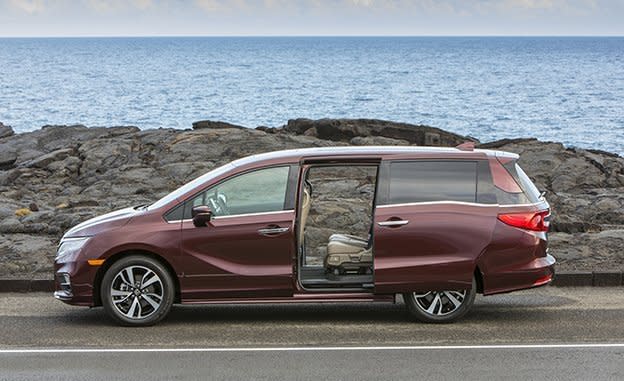
One of the Odyssey’s key distinguishing features—and a leading reason it has been victorious in all but one Car and Driver minivan comparison test that it has participated in since 1999—is a sense of verve from behind the wheel absent from most practicality-first vehicles. This is something chief engineer Chad Harrison promises was again a priority. It shows: The ride feels taut, snubbing vertical motions on the Elite model’s 19-inch wheel-and-tire package, which was the only model we drove. Last year, 18-inch wheels were the top upgrade, but now they’re standard and an inch larger than before, and all Odyssey wheels are aluminum. Although it shares a platform with the Pilot and the Ridgeline, the minivan gets a rear suspension all its own—a multilink design that includes, for the first time, an anti-roll bar. The dampers are situated more vertically and their mounts are pushed out as far as possible to enable a deep cargo hold.
While cranking up the suspension firmness, engineers have dialed in more fore-aft compliance to reduce impact harshness. The new Odyssey also displays a resolute structural solidity, and Honda says torsional rigidity has increased by 44 percent. The steering ratio is more than 10 percent quicker than before, and the Odyssey’s electrically assisted power steering—a rack-mounted dual-pinion setup—is substantially more precise than is the Pilot’s column-mounted assist. However, the brake pedal feels a little soft, just as it does on its platform-mates; a light push squishes the pedal through a substantial amount of its travel before there’s significant deceleration.
Getting Kinkier
Possibly emboldened by consumer acceptance of the kinked character line at the base of the side glass, a signature element added to the fourth-gen Odyssey, the new van’s designers retained that line while overwhelming the profile view with crisscrossing creases in the metal. They’ve even drawn from the cliché bin with the addition of a “floating” roof treatment to the D-pillar. Of course, changing the actual roofline would sacrifice third-row headroom, so it’s a purely visual flourish. It looks overdone to our eyes, which gravitate toward the Chrysler Pacifica in a beauty contest. One improvement is that the sliding-door track is now nicely hidden, having finally been tucked up under the rear glass.
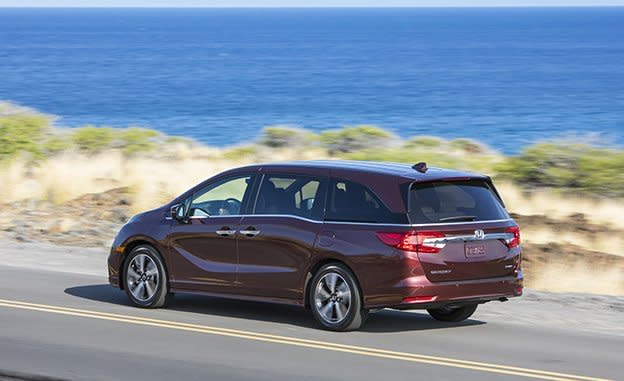
The top two trim levels, Touring and Elite, debut the first ever front-drive 10-speed automatic transaxle. This unit features planetary gearsets for the first time in a Honda-designed gearbox, as well as one of the widest ratio spreads in transmission-dom. The ultra-tall 10th gear can’t even be selected until about 65 mph, where the engine lugs along at barely 1500 rpm. Part-throttle upshifts are extremely smooth, and the transmission quickly recognizes grades and jumps to a lower gear. But we also found some downshifting inconsistencies. For example, while cruising at 55 mph (seventh gear), flooring the throttle yields a swift and direct seven-to-three downshift. However, increase the speed to 60 mph (eighth gear) and the same maneuver delivers a lackadaisical response and four distinctly felt shifts before it finally reaches third gear. The rest of the lineup gets the Pilot’s ZF nine-speed transmission, although chief engineer Harrison promises improved shift smoothness, a sore spot in that SUV.
The biggest dimensional change for 2018 is a 0.7 inch narrowing, done for the purposes of reducing frontal area and improving aerodynamics. Along with active grille shutters, the engine upgrades and the nine- and 10-speed automatics help all Odysseys earn 19/28 mpg city/highway EPA ratings, same as the Pacifica and just 1 highway mpg better than last year. This narrowing means that total interior volume shrinks slightly; to maintain a consistent cargo-volume figure, Honda shifted the third-row seats forward two inches, which reduces rear legroom. But Honda still can claim more legroom than the Toyota Sienna and the Pacifica, and its third row is habitable by adults.
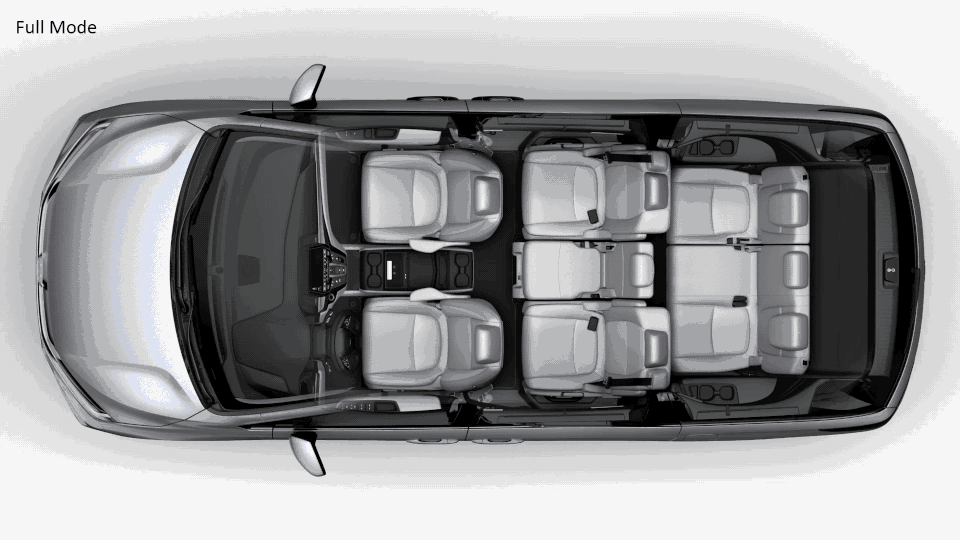
The front seats are soft in all the right places and are extremely accommodating and comfortable, while the lower dashboard has been pushed forward to create more front-seat knee room. The second-row buckets are similarly comfy, one advantage of not having to be slim enough to fold into the floor like the Pacifica’s do. The Odyssey’s latest seating innovation is what Honda calls Magic Slide second-row seats, which is really an evolution of a function that began with the second-gen Odyssey in 1999, where the passenger-side second-row bucket had limited side-to-side adjustability. Now, both center-row bucket seats can slide 13 inches laterally with five latching locations, while retaining fore-aft adjustability. Shifting the seats over creates a larger pathway to the rear seat, without requiring scampering through the middle aisle. Honda mentions numerous modes—seats together, apart, one seat tucked up close between the front seats within close reach of a doting parent—but left one out: Gladiator mode. This is what happens when occupants, probably male ones, realize they can reach the adjustment lever while buckled in their seats and then try to crash into their second-row mate with maximum velocity. Regular haulers of large items take note: Although these seats are removable, their superior comfort and limited folding ability make them heavy and awkward to extract. And the Magic Slide mechanism remains behind, leaving a not-quite-flat load floor.
Got Kids?
Honda provided access to that most insightful of minivan-evaluation tools: children. Specifically, our own kids—ages eight, six, and four—fresh from 12 hours of travel across six time zones and each on the precipice of their own awe-inspiring eruptions. Naturally, they couldn’t be bothered with anything so trivial as spectacular views of the Pacific Ocean or lava-rock formations. They instead gravitated to the rear-seat entertainment, which shrinks from the ceiling-mounted 16.2-inch split screen to a 10.2-inch single-view setup in the same location. The kids prefer the Pacifica’s arrangement, where each outboard second-row occupant commands a touchscreen replete with built-in games. As in the Pacifica, when the navigation system is informed of your destination, the Odyssey can tell rear-seat riders the distance remaining.
An available camera mounted above the second row can send a wide-angle feed of what’s going on back there to the front center-stack screen, and there’s also infrared light to enable nighttime viewing. It’s a boon, although we occasionally wished it had a “record” function to use as evidence in subsequent parental-court hearings. Another new feature is the airplanelike ability to broadcast an announcement through the headphones, which also pauses the movie playing. 4G Wi-Fi is in the mix for the first time but only on the top two trim levels. The rear-seat entertainment is set to take advantage of the Wi-Fi, with a built-in streaming PBS Kids app, and it’s also possible to tether a phone to the system for streaming capability. And the HondaVac vacuum makes a return appearance to clean up after the back-seat snackers.
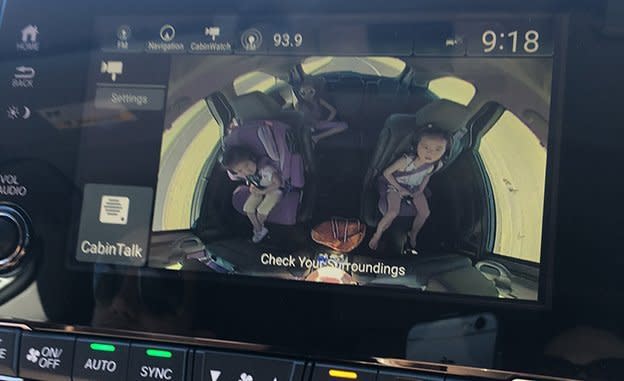
Also debuting here is Honda’s next-generation, Android-based infotainment system, an 8.0-inch-touchscreen setup that eventually will replace the laggy and generally unsatisfying systems in the rest of the Honda lineup. Its layout is tabletlike, with substantially quicker response time and the ability to customize the icon layout, as well as which shortcuts occupy three permanent onscreen locations. It features a volume knob—a twirling innovation unearthed and applied to the latest CR-V—as well as Apple CarPlay and Android Auto connectivity and the ability to receive software updates wirelessly. There’s also an app that enables a phone to manage the rear-seat entertainment, climate control, and navigation system. However, even the top Odyssey trims are a bit sparse on USB charge ports, with just one in the center console and two in the second row.
The Odyssey adds a full complement of driver-assist technologies to EX and higher trims (Honda says that describes roughly 95 percent of its minivan sales), including automated emergency braking, lane-keeping assist, auto high-beams, rear cross-traffic alert, and adaptive cruise control. But, like the Pilot and the Ridgeline, the Odyssey’s cruise control can’t manage stop-and-go traffic, giving up below speeds of about 20 mph.
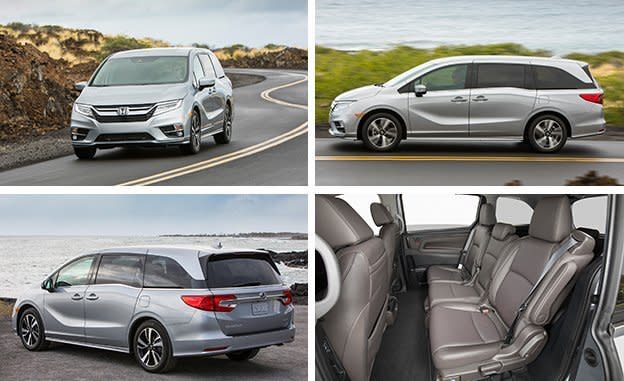
The Sound of Silence
A’a (pronounced “ah-ah”) is the ragged lava peppering the Big Island that you really want to avoid stepping on with bare feet, but it’s also what Odyssey occupants might utter—and what other occupants would be able to hear—after experiencing just how hushed the new Odyssey is at speed. All Odysseys get thicker glass and are far better sealed in general, including for the first time containing acoustic foam sprayed into 14 locations to keep noise at bay. Elite trim models like we drove add even more sound-mitigating measures, such as acoustically insulating laminated side glass for the front and sliding doors (a laminated windshield is fitted to the EX-L and above), as well as additional fender liners and thicker carpet. Although we’ve recently been impressed with the Pacifica in this regard, we’re quite sure the Odyssey will prove to be the new champion of minivan quietness.
Practical, comfortable, configurable, feature-rich, and exceptionally quiet. Aside from perhaps the styling, this is a compelling set of attributes that should keep the Odyssey energized until its next big event.
Specifications >
VEHICLE TYPE: front-engine, front-wheel-drive, 7- or 8-passenger, 4-door van
BASE PRICES: LX, $30,930;
EX, $34,800;
EX-L, $38,300;
Touring, $45,450;
Elite, $47,610
ENGINE TYPE: SOHC 24-valve V-6, aluminum block and heads, direct fuel injection
Displacement: 212 cu in, 3471 cc
Power: 280 hp @ 6000 rpm
Torque: 262 lb-ft @ 4700 rpm
TRANSMISSIONS: 9-speed automatic with manual shifting mode, 10-speed automatic with manual shifting mode
DIMENSIONS:
Wheelbase: 118.1 in
Length: 203.2 in
Width: 78.5 in Height: 68.3–69.6 in
Passenger volume: 163–167 cu ft
Cargo volume: 39 cu ft
Curb weight (C/D est): 4400–4600 lb
PERFORMANCE (C/D EST):
Zero to 60 mph: 6.5 sec
Zero to 100 mph: 16.4 sec
Standing ¼-mile: 15.1 sec
Top speed: 112 mph
FUEL ECONOMY:
EPA combined/city/highway: 22/19/28 mpg

 Yahoo Autos
Yahoo Autos 